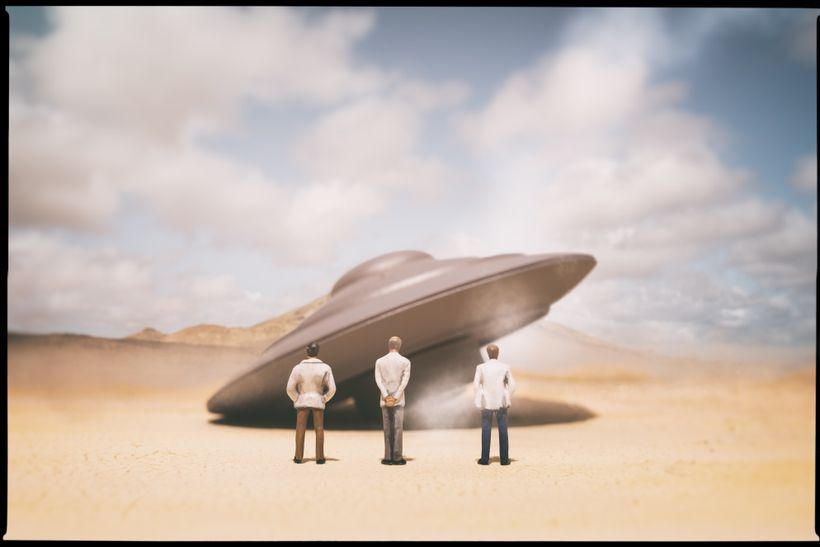The Anthropocene Generalized: Evolution of Exo-Civilizations and Their Planetary Feedback
AstrobiologyA. Frank
2018
We present a framework for studying generic behaviors possible in the interaction between a resource-harvesting technological civilization (an exo-civilization) and the planetary environment in which it evolves. Using methods from dynamical systems theory, we introduce and analyze a suite of simple equations modeling a population which consumes resources for the purpose of running a technological civilization and the feedback those resources drive on the state of the host planet. The feedbacks can drive the planet away from the initial state the civilization originated in and into domains that are detrimental to its sustainability. Our models conceptualize the problem primarily in terms of feedbacks from the resource use onto the coupled planetary systems. In addition, we also model the population growth advantages gained via the harvesting of these resources. We present three models of increasing complexity: (1) Civilization-planetary interaction with a single resource; (2) Civilization-planetary interaction with two resources each of which has a different level of planetary system feedback; (3) Civilization-planetary interaction with two resources and nonlinear planetary feedback (i.e., runaways). All three models show distinct classes of exo-civilization trajectories. We find smooth entries into long-term, “sustainable” steady states. We also find population booms followed by various levels of “die-off.” Finally, we also observe rapid “collapse” trajectories for which the population approaches n = 0. Our results are part of a program for developing an “Astrobiology of the Anthropocene” in which questions of sustainability, centered on the coupled Earth-system, can be seen in their proper astronomical/planetary context. We conclude by discussing the implications of our results for both the coupled Earth system and for the consideration of exo-civilizations across cosmic history.
View more
The Silurian Hypothesis: Would it be possible to detect an industrial civilization in the geological record?
Earth and Planetary AstrophysicsA. Frank
2018
If an industrial civilization had existed on Earth many millions of years prior to our own era, what traces would it have left and would they be detectable today? We summarize the likely geological fingerprint of the Anthropocene, and demonstrate that while clear, it will not differ greatly in many respects from other known events in the geological record. We then propose tests that could plausibly distinguish an industrial cause from an otherwise naturally occurring climate event.
View more
The formation and evolution of wind-capture discs in binary systems
Monthly Notices of the Royal Astronomical SocietyM. Huarte-Espinosa, J. Carroll-Nellenback, J. Nordhaus, A. Frank, E. G. Blackman
2013
We study the formation, evolution and physical properties of accretion discs formed via wind capture in binary systems. Using the adaptive mesh refinement (AMR) code AstroBEAR, we have carried out high-resolution 3D simulations that follow a stellar mass secondary in the corotating frame as it orbits a wind producing asymptotic giant branch (AGB) primary. We first derive a resolution criteria, based on considerations of Bondi–Hoyle flows, that must be met in order to properly resolve the formation of accretion discs around the secondary. We then compare simulations of binaries with three different orbital radii (Ro = 10, 15, 20 au). Discs are formed in all three cases, however, the size of the disc and, most importantly, its accretion rate decreases with orbital radii. In addition, the shape of the orbital motions of material within the disc becomes increasingly elliptical with increasing binary separation. The flow is mildly unsteady with ‘fluttering’ around the bow shock observed. The discs are generally well aligned with the orbital plane after a few binary orbits. We do not observe the presence of any large-scale, violent instabilities (such as the flip-flop mode). For the first time, moreover, it is observed that the wind component that is accreted towards the secondary has a vortex tube-like structure, rather than a column-like one as it was previously thought. In the context of AGB binary systems that might be precursors to pre-planetary nebula (PPN) and planetary nebula (PN), we find that the wind accretion rates at the chosen orbital separations are generally too small to produce the most powerful outflows observed in these systems if the companions are main-sequence stars but marginally capable if the companions are white dwarfs. It is likely that many of the more powerful PPN and PN involve closer binaries than the ones considered here. The results also demonstrate principles of broad relevance to all wind-capture binary systems.
View more
Efficient parallelization for AMR MHD multiphysics calculations; implementation in AstroBEAR
Journal of Computational PhysicsCarroll-Nellenback, J.J., Shroyer, B., Frank, A., Ding, C.
2013
Current adaptive mesh refinement (AMR) simulations require algorithms that are highly parallelized and manage memory efficiently. As compute engines grow larger, AMR simulations will require algorithms that achieve new levels of efficient parallelization and memory management. We have attempted to employ new techniques to achieve both of these goals. Patch or grid based AMR often employs ghost cells to decouple the hyperbolic advances of each grid on a given refinement level. This decoupling allows each grid to be advanced independently. In AstroBEAR we utilize this independence by threading the grid advances on each level with preference going to the finer level grids. This allows for global load balancing instead of level by level load balancing and allows for greater parallelization across both physical space and AMR level. Threading of level advances can also improve performance by interleaving communication with computation, especially in deep simulations with many levels of refinement. While we see improvements of up to 30% on deep simulations run on a few cores, the speedup is typically more modest (5–20%) for larger scale simulations. To improve memory management we have employed a distributed tree algorithm that requires processors to only store and communicate local sections of the AMR tree structure with neighboring processors. Using this distributed approach we are able to get reasonable scaling efficiency (>80%) out to 12288 cores and up to 8 levels of AMR – independent of the use of threading.
View more
On the Structure and Stability of Magnetic Tower Jets
The Astrophysical JournalHuarte-Espinosa, M., Frank, A., Blackman, E. G., Ciardi, A., Hartigan, P., Lebedev, S. V., Chittenden, J. P.
2012
Modern theoretical models of astrophysical jets combine accretion, rotation, and magnetic fields to launch and collimate supersonic flows from a central source. Near the source, magnetic field strengths must be large enough to collimate the jet requiring that the Poynting flux exceeds the kinetic energy flux. The extent to which the Poynting flux dominates kinetic energy flux at large distances from the engine distinguishes two classes of models. In magneto-centrifugal launch models, magnetic fields dominate only at scales lesssim 100 engine radii, after which the jets become hydrodynamically dominated (HD). By contrast, in Poynting flux dominated (PFD) magnetic tower models, the field dominates even out to much larger scales. To compare the large distance propagation differences of these two paradigms, we perform three-dimensional ideal magnetohydrodynamic adaptive mesh refinement simulations of both HD and PFD stellar jets formed via the same energy flux. We also compare how thermal energy losses and rotation of the jet base affects the stability in these jets. For the conditions described, we show that PFD and HD exhibit observationally distinguishable features: PFD jets are lighter, slower, and less stable than HD jets. Unlike HD jets, PFD jets develop current-driven instabilities that are exacerbated as cooling and rotation increase, resulting in jets that are clumpier than those in the HD limit. Our PFD jet simulations also resemble the magnetic towers that have been recently created in laboratory astrophysical jet experiments.
View more




































































